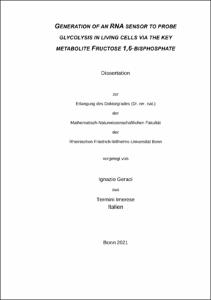Geraci, Ignazio: Generation of an RNA sensor to probe glycolysis in living cells via the key metabolite fructose 1,6-bisphosphate. - Bonn, 2021. - Dissertation, Rheinische Friedrich-Wilhelms-Universität Bonn.
Online-Ausgabe in bonndoc: https://nbn-resolving.org/urn:nbn:de:hbz:5-62133
Online-Ausgabe in bonndoc: https://nbn-resolving.org/urn:nbn:de:hbz:5-62133
@phdthesis{handle:20.500.11811/9184,
urn: https://nbn-resolving.org/urn:nbn:de:hbz:5-62133,
author = {{Ignazio Geraci}},
title = {Generation of an RNA sensor to probe glycolysis in living cells via the key metabolite fructose 1,6-bisphosphate},
school = {Rheinische Friedrich-Wilhelms-Universität Bonn},
year = 2021,
month = jun,
note = {Glycolysis is the cornerstone of cell metabolism and is one of the oldest biochemical pathways known to life. Yet, methods to study glycolysis in single living cells are lacking. The glycolytic intermediate Fructose 1,6-bisphosphate (FBP) generated interest because seminal studies correlated it with glucose influx. Here, a gene-encoded RNA fluorescence sensor was developed for the qualitative assessment of FBP to be used as a metabolic study tool.
For this purpose, the concept of allosteric communication of RNA modules was explored to convert the constitutively fluorogenic RNA Spinach into an FBP-dependent variant. Ad hoc designed libraries were equipped with Spinach?s fluorogenic G-quadruplex core and tested to identify, within the RNA pools, whose sequence space would promote allosteric regulation. To scout FBP-responsive allosteric sequences, the RNA libraries were subjected to selection methodologies based upon SELEX (Systematic evolution of ligands by exponential enrichment) or on a microfluidic-assisted in vitro compartmentalization pipeline (µIVC). Numerous SELEX trials failed to enrich ligand-induced fluorescence sequences with either FBP or other test molecules, whereas µIVC allowed the identification of sequence 81 (s81), a ratiometric fluorescent sensor for FBP, from a chimeric library design of Spinach with the C45 aptamer, an in vitro selected RNA that binds to FBP.
S81 was characterized in vitro to assess its binding to FBP and DFHBI, the cognate dye of Spinach, and a possible sensing mechanism was laid out on the grounds of the parental chimeric library design. Finally, s81 was transiently expressed in embryonic kidney cells to probe the FBP variation upon oligomycin-induced glycolytic flux increase. Contrary to the literature, FBP was found to decrease upon oligomycin-treatment. Still, the assay provided a window to evaluate the sensor?s performance in the cellular context by demonstrating s81 poly-specificity to phosphate-bearing metabolites.
Nevertheless, the identification of s81 as an FBP-responsive fluorogenic RNA showcased the advantages of combining structurally-guided designs with high-throughput screening pipelines to identify allostery-regulated iterations, which could be straight-forwardly characterized in vitro and tested in cells. This approach is preferable to current design-build-test cycles for RNA sensor discovery, for it allows the screening of entire libraries of millions of different sequences in a non-iterative and holistic manner.},
url = {https://hdl.handle.net/20.500.11811/9184}
}
urn: https://nbn-resolving.org/urn:nbn:de:hbz:5-62133,
author = {{Ignazio Geraci}},
title = {Generation of an RNA sensor to probe glycolysis in living cells via the key metabolite fructose 1,6-bisphosphate},
school = {Rheinische Friedrich-Wilhelms-Universität Bonn},
year = 2021,
month = jun,
note = {Glycolysis is the cornerstone of cell metabolism and is one of the oldest biochemical pathways known to life. Yet, methods to study glycolysis in single living cells are lacking. The glycolytic intermediate Fructose 1,6-bisphosphate (FBP) generated interest because seminal studies correlated it with glucose influx. Here, a gene-encoded RNA fluorescence sensor was developed for the qualitative assessment of FBP to be used as a metabolic study tool.
For this purpose, the concept of allosteric communication of RNA modules was explored to convert the constitutively fluorogenic RNA Spinach into an FBP-dependent variant. Ad hoc designed libraries were equipped with Spinach?s fluorogenic G-quadruplex core and tested to identify, within the RNA pools, whose sequence space would promote allosteric regulation. To scout FBP-responsive allosteric sequences, the RNA libraries were subjected to selection methodologies based upon SELEX (Systematic evolution of ligands by exponential enrichment) or on a microfluidic-assisted in vitro compartmentalization pipeline (µIVC). Numerous SELEX trials failed to enrich ligand-induced fluorescence sequences with either FBP or other test molecules, whereas µIVC allowed the identification of sequence 81 (s81), a ratiometric fluorescent sensor for FBP, from a chimeric library design of Spinach with the C45 aptamer, an in vitro selected RNA that binds to FBP.
S81 was characterized in vitro to assess its binding to FBP and DFHBI, the cognate dye of Spinach, and a possible sensing mechanism was laid out on the grounds of the parental chimeric library design. Finally, s81 was transiently expressed in embryonic kidney cells to probe the FBP variation upon oligomycin-induced glycolytic flux increase. Contrary to the literature, FBP was found to decrease upon oligomycin-treatment. Still, the assay provided a window to evaluate the sensor?s performance in the cellular context by demonstrating s81 poly-specificity to phosphate-bearing metabolites.
Nevertheless, the identification of s81 as an FBP-responsive fluorogenic RNA showcased the advantages of combining structurally-guided designs with high-throughput screening pipelines to identify allostery-regulated iterations, which could be straight-forwardly characterized in vitro and tested in cells. This approach is preferable to current design-build-test cycles for RNA sensor discovery, for it allows the screening of entire libraries of millions of different sequences in a non-iterative and holistic manner.},
url = {https://hdl.handle.net/20.500.11811/9184}
}






